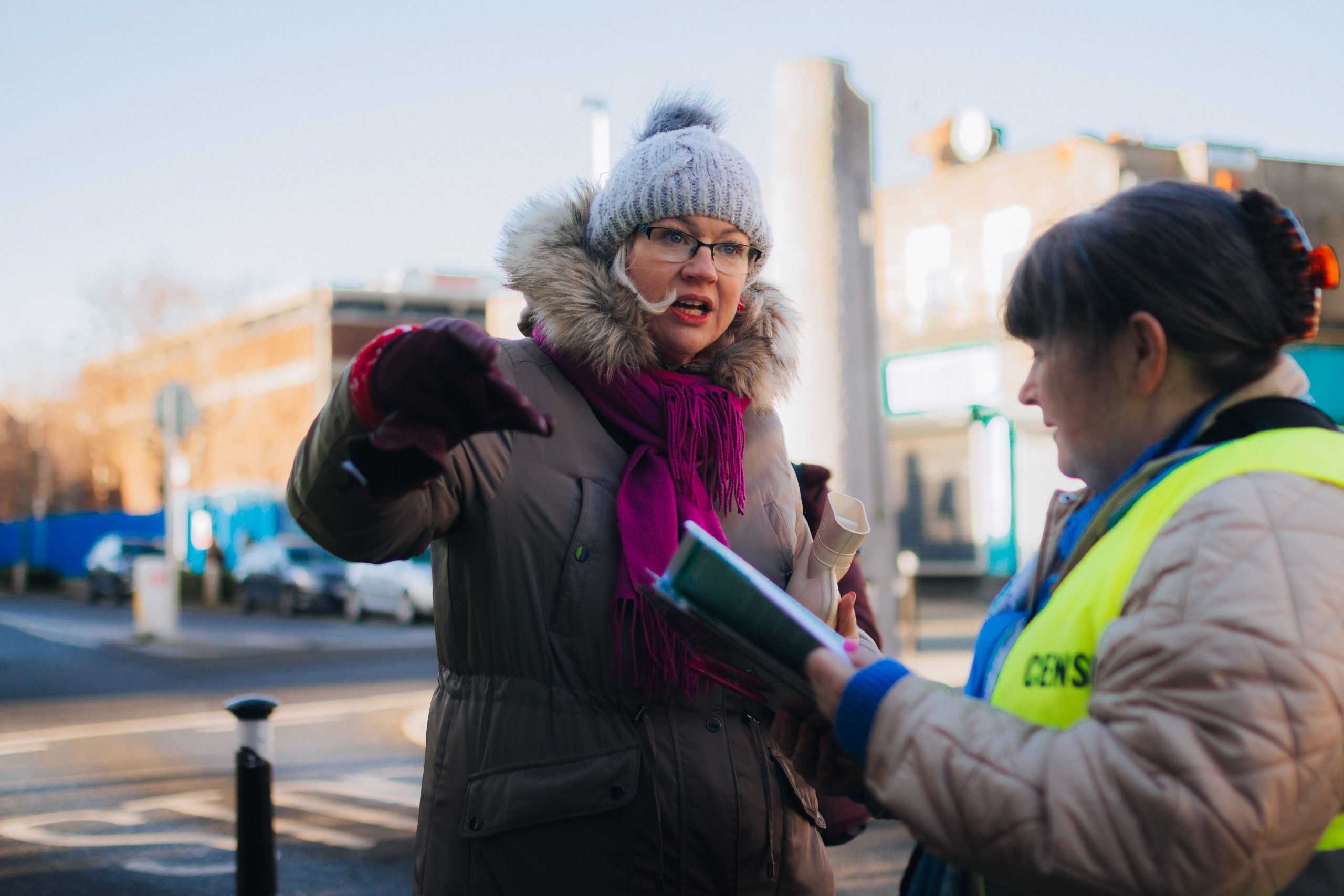
At WFT Ireland, we are constantly inspired and impressed by the caliber of work being done by our members across the film industry. So much so, that we love to celebrate their achievements with our slot ‘Member in Focus’. With June almost over, we are thrilled to feature the work of Patricia Kelly, a talented writer and director, who is just about to screen her first feature at the Galway Film Fleadh. We spoke with Patricia about her wonderful film Verdigris, her love of stories and how she got her start in the industry.
How did you get into film? Can you tell us about your journey as a filmmaker?
I began as an actor, then pressed pause to get a sensible job so I could buy a house. In my 30s, with one small child, I did a BA in English Literature with the Open University. Then timed it so that my maternity leave with my second child coincided with the academic year, so I could do an MA in Screenwriting. I focused on honing that craft for nearly a decade before starting to produce and direct my own shorts – primarily out of frustration at not even getting my work read, never mind produced. I used to joke that I was Ireland’s most reluctant director but I’ve accepted my fate now.
As a writer, where do you get your inspiration from?
My own fallibility, life experiences related by family and friends, interesting observations from the wider universe. Ideas usually stem from my trying to make sense of the world. For example, I was a census enumerator in 2016 in the north inner city, where I was living at the time and my route took me around lots of Jewel’s neighbourhood. I found it to be a tough but fascinating experience and knew I had to write about it at some point.
A powerful story. Can you tell me about your writing process from idea inception to the shooting draft?
I was made redundant from my day job due to Covid and had a chunk of time to really try to get a micro-budget feature script into shape. Verdigris was actually my second attempt at this, my first will hopefully be Film No. 2 but it just couldn’t be made for the tiny sum I knew I could borrow. So, I started again, took my census-enumerator-in-the-inner-city story and worked out a strong outline. I have been a member of a writers’ group for over ten years and brought this outline to them, used their constructive feedback to craft the first draft, then repeated this process over and over. After one of the early drafts, I tried something new and hired a studio and a number of actors to workshop the characters of Marian and Jewel and their dynamic. This was a very useful exercise and the next draft was a lot stronger because of it. Finally, I took part in Mary Kate O’Flanagan’s Making a Scene workshops with Verdigris and this helped to create a draft solid enough to get cast and crew on board. The shooting script was fully formed through the rehearsal, location scouting and scheduling processes.
What was your experience capturing those two very different communities?
Over the decades I’ve gained a fair bit of experience of both communities, which again is largely what inspired this story. I come from a lower-middle class Dublin background myself but a lot of my wider family are from working class areas. My maternal grandmother came from the Gardiner Street tenements, around the corner from Jewel’s flats. But I’ve also lived in leafy suburbs and been exposed to a lot of privilege from day-jobbing in corporate firms. Actually, one International Women’s Day we had a Women’s Aid representative visit the firm and said most people think that domestic abuse is a working class problem and don’t realise how prevalent it is in middle and upper classes. This definitely played a part in Marian’s story. I did have to do a fair bit of research on the sex industry though, through reading biographies, listening to podcasts and talking to sex-workers. So, I learned a lot in the process.
Can you tell us about casting – what was it you were looking for in your two woman leads?
Marian’s role was tricky in that she had to be able to be invisible and unremarkable, but still capture our attention for 90 minutes. When Geraldine read for the role, she brought such a gentleness and subtlety that I felt would make an audience lean in and strongly empathise with her. Jewel’s role required someone who could switch from being a child to an adult and back again, in an instant. A character constantly shifting, having learnt to be something different to everyone she meets, in order to survive. Maya brought both playfulness and maturity and, as she is a very intuitive actor, I knew she could bring a touch of magic to the role. I’m thrilled that the Fleadh have nominated her for the Bingham Ray New Talent Award, it’s well deserved. And Geraldine is one of the writers shortlisted for the Pitching Award – a talented bunch!
This is your first feature, with such a polished look and feel. Can you tell me how you and Paul put together the resources?
Thank you very much, I’m really happy with how it looks and sounds. We weren’t lucky enough to get any funding, so we raised about 10% of the budget from crowd-funding and the other 90% is through loans. DoP Tania Freimuth is a Canon Ambassador, so they very kindly supported the project with a loan of a C500 MKII Full Frame 5.9K and a collection of lovely primes and zooms and she borrowed other equipment from Tilta. Other than that, we had to be very clear with all HoDs that although we could pay every cast and crew member the same basic day rate, they had almost nothing in their budget for their department, so everyone found very creative ways to do a lot with very little. So many of the highly experienced team worked for a fraction of their normal rate, for which I am truly grateful. Fingers crossed I’ll be able to splash the cash on them on another project in the future.
How long was the shoot? Any “on-set” stories?
The shoot was an incredibly tight 15 days Monday to Friday for three weeks in January and early February. The first week was entirely outdoors and although we were blessed that we had zero rain, it was during that shockingly cold week where it hit -4 degrees some days. And we all know how much hanging around there is on a set, so it was a real challenge to stave off the hypothermia with hot water bottles, flasks and copious layers of clothing. I still smile when I’m looking at the film and see the actors’ breaths. The only way we managed to get it all in the 15 days was from being so prepared and having a fantastic 1st AD in Brian McDonnell. Myself and DoP Tania Freimuth put a huge amount of work in advance, location scouting and extensive shot listing and so on. And then, we were able to rehearse fully with the cast in each shoot location, which I believe made all the difference.
What did you learn in the process of making your first feature?
That preparation is as important as everyone says. I find it really frees me up on set. Having a solid Plan A, and at times a Plan B, for everything meant I could relax about responding and reacting in the moment when something unexpected – good or bad – occurred. Also, I found there to be so much support, enthusiasm and good will in moving from shorts to a micro-budget feature, which really makes the heart swell.
Did much change in the edit?
Would you believe the assembly edit was a whopping 2 hours 45 minutes, for an 86-page script? So, there was quite a bit of work to get it down to something close to 90 minutes. We did have to cut out two full scenes. And a couple of others were originally cut out but I managed to sneak them back in by cross-cutting with other scenes.
Are you looking forward to finally screening it (and where can we see it)?
I’m still a little in shock that it’ll be in front of an audience so soon. Verdigris will have its world premiere at the Galway Film Fleadh on Friday 14th July at 4:30pm. When I met Paul FitzSimons for coffee last autumn and suggested he and Prelude Content collaborate on the project which was scheduled for January/February, he asked me if it could be ready for Galway. I said, “Galway? Whose final deadline is mid-March? Well, we’ll give it a go!” And each time a cast or crew member asked what the plan was for the film, we’d say “Well, we’re aiming for Galway”. So, to have gotten the film across the line in time, and been successful in our plan to premiere at the Fleadh, is really sweet. But I have to give a shout out to Maeve McGrath and her team for being so supportive and patient with us. It’s all very exciting.
Thanks so much for sharing this with us! Written and Directed by WFT Member Patricia Kelly, Verdigris premieres at the 35th Galway Film Fleadh on 14th July.
About Patricia Kelly
Patricia Kelly is an independent filmmaker and founder of MnáMná Films, an Irish production company based in Dublin. She is the writer and director of feature film Verdigris, which premieres at the 35th Galway Film Fleadh. Her award-winning short films have screened worldwide at film festivals, online and on TV and she has had a comedy radio play broadcast on RTE Radio 1. She has an MA in Screenwriting for Film & TV and was a script reader for Northern Ireland Screen for four years. Patricia is passionate about amplifying marginalised voices, featuring characters and stories less often seen on screen.



